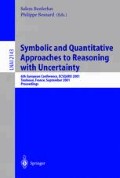Abstract
A method is proposed for reducing the size of a frame of discernment, in such a way that the loss of information content in a set of belief functions is minimized. This approach allows to compute strong inner and outer approximations which can be combined efficiently using the Fast Möbius Transform algorithm.
Access this chapter
Tax calculation will be finalised at checkout
Purchases are for personal use only
Preview
Unable to display preview. Download preview PDF.
References
M. Bauer. Approximation algorithms and decision making in the Dempster-Shafer theory of evidence-an empirical study. International Journal of Approximate Reasoning, 17:217–237, 1997.
T. Denœux. Inner and outer clustering approximations of belief structures. In Proceedings of IPMU’2000, volume 1, pages 125–132, Madrid, July 2000.
D. Dubois and H. Prade. Representation and combination of uncertainty with belief functions and possibility measures. Comput. Intell., 4:244–264, 1988.
D. Dubois and H. Prade. Consonant approximations of belief measures. International Journal of Approximate Reasoning, 4:419–449, 1990.
D. Harmanec. Faithful approximations of belief functions. In K. B. Laskey and H. Prade, editors, Uncertainty in Artificial Intelligence 15 (UAI99), Stockholm, Sweden, 1999.
Lowrance J. D, T. D. Garvey, and T. M. Strat. A framework for evidential-reasoning systems. In T. Kehler et al., editor, Proceedings of AAAI’86, volume 2, pages 896–903, Philadelphia, August 1986. AAAI.
A. K. Jain and R. C. Dubes. Algorithms for clustering data. Prentice-Hall, Englewood Cliffs, NJ., 1988.
R. Kennes. Computational aspects of the Möbius transform of graphs. IEEE Trans. SMC, 22:201–223, 1992.
G. J. Klir and M. J. Wierman. Uncertainty-Based Information. Elements of Generalized Information Theory. Springer-Verlag, New-York, 1998.
P. Orponen. Dempster’s rule of combination is # p-complete. Artificial Intelligence, 44:245–253, 1990.
S. Petit-Renaud and T. Denœux. Handling different forms of uncertainty in regression analysis: a fuzzy belief structure approach. In A. Hunter and S. Pearsons, editors, Symbolic and quantitative approaches to reasoning and uncertainty (EC-SQARU’99), pages 340–351, London, June 1999. Springer Verlag.
G. Shafer. A mathematical theory of evidence. Princeton University Press, Princeton, N.J., 1976.
P. Smets. The Transferable Belief Model for quantified belief representation. In D. M. Gabbay and P. Smets, editors, Handbook of Defeasible reasoning and uncertainty management systems, volume 1, pages 267–301. Kuwer Academic Publishers, Dordrecht, 1998.
P. Smets. Practical uses of belief functions. In K. B. Laskey and H. Prade, editors, Uncertainty in Artificial Intelligence 15 (UAI99), pages 612–621, Stockholm, Sweden, 1999.
B. Tessem. Approximations for efficient computation in the theory of evidence. Artificial Intelligence, 61:315–329, 1993.
N. Wilson. Algorithms for dempster-shafer theory. In D. M. Gabbay and P. Smets, editors, Hanbook of defeasible reasoning and uncertainty management. Volume 5: Algorithms for Uncertainty and Defeasible Reasoning, pages 421–475. Kluwer Academic Publishers, Boston, 2000.
Author information
Authors and Affiliations
Editor information
Editors and Affiliations
Rights and permissions
Copyright information
© 2001 Springer-Verlag Berlin Heidelberg
About this paper
Cite this paper
Yaghlane, A.B., Denœux, T., Mellouli, K. (2001). Coarsening Approximations of Belief Functions. In: Benferhat, S., Besnard, P. (eds) Symbolic and Quantitative Approaches to Reasoning with Uncertainty. ECSQARU 2001. Lecture Notes in Computer Science(), vol 2143. Springer, Berlin, Heidelberg. https://doi.org/10.1007/3-540-44652-4_32
Download citation
DOI: https://doi.org/10.1007/3-540-44652-4_32
Published:
Publisher Name: Springer, Berlin, Heidelberg
Print ISBN: 978-3-540-42464-2
Online ISBN: 978-3-540-44652-1
eBook Packages: Springer Book Archive

